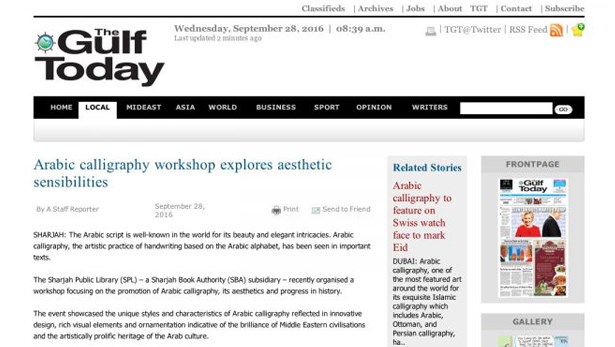Arabic Calligraphy Workshop Explores Aesthetic Sensibilities
 Date: - Sep 28, 2016
Date: - Sep 28, 2016 
The Arabic script is well-known in the world for its beauty and elegant intricacies. Arabic calligraphy, the artistic practice of handwriting based on the Arabic alphabet, has been seen in important texts. The Sharjah Public Library (SPL)–a Sharjah Book Authority (SBA) subsidiary – recently organised a workshop focusing on the promotion of Arabic calligraphy, its aesthetics and progress in history. The event showcased the unique styles and characteristics of Arabic calligraphy reflected in innovative design, rich visual elements and ornamentation indicative of the brilliance of Middle Eastern civilisations and the artistically prolific heritage of the Arab culture.The workshop not only focused on Arabic calligraphy’s aesthetic criteria underlined by special instruments used to create unique forms of the Arabic alphabet, but also the artistic element illustrated by its glamorous patterns and charming graphics. “This workshop resulted from our keenness to promote crucial elements of our Arab identity.
The uniqueness of Arabic calligraphy is manifested by its architecture and design. “The blending of letters forming an entity of rare beauty and artistic expression points to the alphabet’s inherent aesthetic richness. “Arabic calligraphy is one of the most important historical bridges in the transfer of our knowledge and culture. “It is also credited as being a common art frame representing cultural identities across Arab nations,” said Sara Al Marzouqi, Sharjah Public Library Manager.“Through this workshop, we have endeavoured to empower the Arabic language by encouraging innovation and creativity.“This will serve to enhance the fundamentals of cultural sponsorship, and through the inclusion of reading, the identification of the rich aesthetics of the language. “The UAE gives the Arabic language special importance because it is the main component of our national identity, and the primary link with Islamic culture. “Nurturing and developing the Arabic language is our foremost responsibility towards present and future generations,” she added.The workshop featured storytelling sessions on a group of calligraphers throughout history, enunciating how historical time-shifts witnessed the development of some calligraphy art styles, with the decay and degeneration of others, exploring its historical discourse among peoples and civilisations. This activity provided a valuable account on the development of Arabic calligraphy in its different stages.Participants at the workshop experienced calligraphy writing with different instruments such as dried reed and bamboo pens, regular ink pens and special ink pens for glossy paper, in addition to writing their initials and names using glitter and gold calligraphy ink.The workshop highlighted the art of ornamentation as one of the most important components of calligraphy, and a fundamental pillar of Islamic Art.
Ornamentation in Arabic calligraphy is characterised by decorative calligraphic, botanical and architectural inscriptions, which reveal the creative dimension of the Arabic language.The workshop was conducted by Ali Al Hammadi, Member of the Emirates Society for Arabic Calligraphy and Islamic Ornamentation, who is specialised in the Kufic styles – the oldest calligraphic form of the various Arabic scripts – and Islamic Ornamentation.



